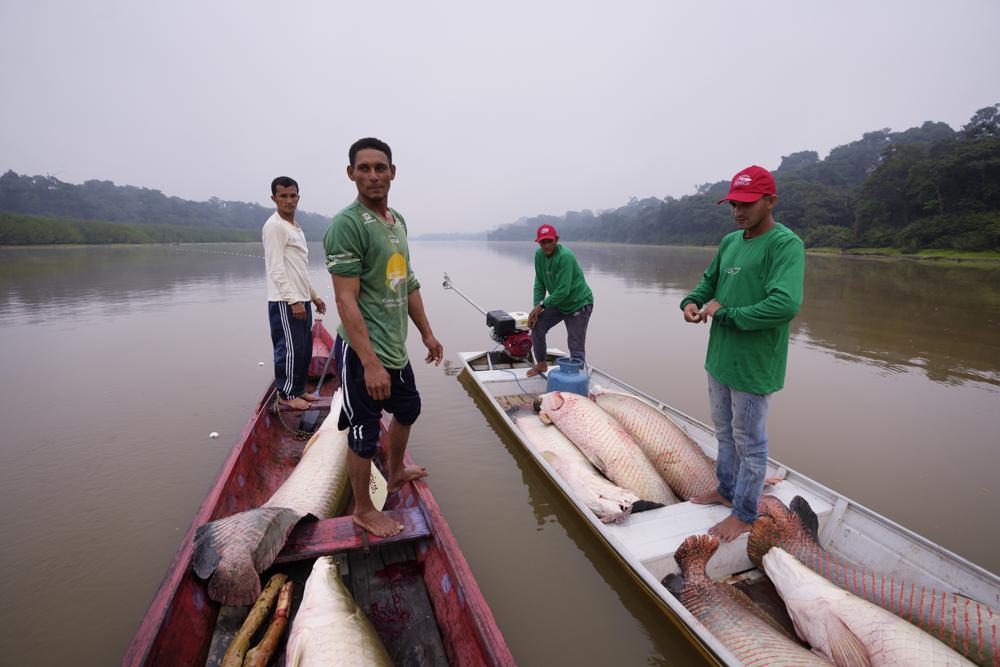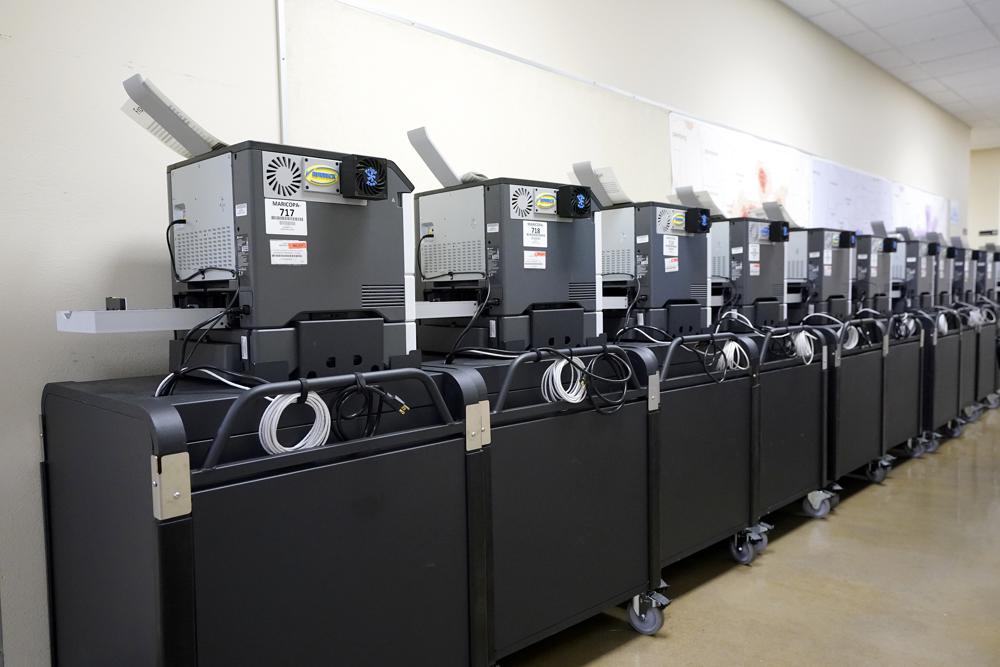Even in the most biodiverse rainforest of the world, the pirarucu, also known as arapaima, stands out.
First, there is its mammoth size: It can weigh up to 200 kilos (440 pounds), by far the largest of 2,300 known fish species in the Amazon. It is found primarily in floodplain lakes across the Amazon basin, including the region of Medio Jurua.
Second, the giant fish not so long ago nearly vanished from Jurua, as vessels swept the lakes with large nets. The illegal and unsustainable fishing left river and Indigenous communities struggling to catch their staple food. And it left pirarucu designated as threatened with extinction, unless trade in the fish is closely controlled by the Convention on International Trade in Endangered Species of Wild Fauna and Flora.
But now something remarkable has happened. The fish has come back to the lakes of Medio Jurua. The story of how involves people of different backgrounds cooperating on many levels — a vision of what’s possible that veterans of the Amazon say they’ve seen nowhere else across the vast region.
Change began in the late 1990s. With the assistance of a Dutch Catholic priest, rubber tappers organized and led a campaign to persuade the federal government to create the Medio Jurua Extractive Reserve. They proposed that river communities could take from the forest and its lakes — up to a point — and within protected areas.
It worked. Now, local communities produce açai, vegetable oils and rubber, and they leave the forest standing. Most successful of all has been the management of pirarucu.
Riverine settler communities, organized into associations, also reached agreement with neighboring Deni Indigenous people, who have suffered in the past from invasions by rubber-tappers and fishermen. Now they are part of the managed fishing of pirarucu, which improved relations between Indigenous people and non-Indigenous.
Managing the comeback has required social organization, cooperation and complex logistics. Illegal fishing has been sharply reduced. Pirarucu are flourishing.
The virtuous cycle plays out in the region of Carauari, which stretches along 650 kilometers (404 miles) of the Jurua River and is home to 35,000 people.
To see how things could have gone, look no further than the neighboring Javari Valley, where British journalist Dom Phillips and Indigenous expert Bruno Pereira were murdered last June.
The backdrop of that tragedy is a decades-old dispute between Indigenous communities and former rubber tappers who were hired by local businessmen to do illegal fishing, targeting mostly the pirarucu. Two local fishermen confessed to the crimes.
Illegal fishing is rampant in Brazil. It’s the second most frequent environmental crime on protected land, after logging, according to an academic study based on official data. Brazil´s conservation agency issued 1,160 infraction notices for illegal fishing — a quarter of all infractions — over a recent five-year period.
“Javari is a portrait of what Medio Jurua was like in the 1980s,” Manoel Cunha, the main leader of the local rubber tappers, told The Associated Press during a boat trip to Sao Raimundo, his home community and one of the ones that takes part in regulated fishing. “We managed to get rid of fishing companies and invading fishermen by monitoring and management. You have been on this river for days now, and you have not seen any fishing boats except the ones from our organizations. There is no more room for them here.”
Pirarucu fishing is done once a year, around September, the period of lowest water. Fishing quotas are possible due to another remarkable characteristic of the pirarucu: It is one of the few fish species in the world that surfaces to breathe. It does that with a big splash, flashing its red tail out of the water.
A local fisherman and a researcher in the nearby Mamirarua region developed a way to take advantage of this, and count the fish since they stay underwater for no more than 20 minutes. The government now recognizes this counting method.
The survey is done once a year by certified fishermen, after taking a course. By law, only 30% of the pirarucu in a certain area can be fished the following year.
This controlled fishing has led to a surge in its population in regions where it’s employed. In Sao Raimundo region, there were 1,335 pirarucus in the nearby lakes in 2011, when the managed fishing began. Last year, there were 4,092 specimens, according to their records.
In the Carauari region, the number of pirarucu spiked from 4,916, in 2011, to 46,839, ten years later.
An AP team accompanied the first of the seven days of fishing in Sao Raimundo. Picture a few dozen houses, with running water, connected by well-maintained wooden footbridges amid açai palm trees. Thirty-four families call it home. Most belong to Cunha´s extended family, whose ancestors arrived in the region from the impoverished and drought-ravaged Northeast during the rubber boom to work as tappers.
“Our pirarucu is so tasty, everybody that eats it falls in love with it and wants more,” Rosilda da Cunha, a sister of Manoel who lives in Sao Raimundo, told the AP.
Pirarucu bring money into the community, she said. This year, the goal is to buy a solar panel system to replace the diesel-fueled generator. Another share of the money goes to the community members who participate in the fishing. Women’s and men’s salaries are equal.
To catch pirarucu, fishermen use special, stronger nets they weave themselves. The holes are large enough to allow smaller specimens to go through, as taking fish under five feet is prohibited.
When the fishers catch one, they haul in the net and club the fish in the head. Then they put it in their small boat. When it´s very heavy, two or three men are required to do the job.
The pirarucus are then taken from the lakes to a large boat by the Jurua River. There they are gutted, a task that is mostly done by women, and put on ice. All the production is bought by the Association of Rural Producers of Carauari, known as Asproc, the region´s umbrella organization, so the fishers are never at the mercy of middlemen.
Founded by rubber tappers who wanted to liberate themselves from slave-like labor conditions, Asproc has grown to be one of the most important grassroots entities in the entire Amazon. It runs programs on everything from sanitation, to community markets to higher education, innovating along the way. It now sells pirarucu to Brazil´s main cities including Sao Paulo and Brasília, a complex endeavor that involves several days of transport by boat and road and usually takes more than two weeks.
Asproc´s success has attracted several partnerships. One is counterintuitive — the United States Forest Service, which supported the creation of a brand, the Gosto da Amazônia (Amazon Taste), that promotes the pirarucu nationwide, and the Agency for International Development (USAID), which helped to finance a warehouse for processing fish in Carauari city, where the pirarucu is cut, frozen and packaged.
“This project is unique as it requires a strong governance structure,” Ted Gehr, USAID mission director in Brazil, told the AP during his first visit to the Sao Raimundo community. “Everybody is in agreement that they may have to sacrifice and not be able to fish all of the pirarucu that are available but knowing that they’ll reproduce more, and that in the long run they will be more valuable.”
The Medio Jurua region is blessed with remoteness. It has no access by road. So far it is free from the deforestation and fire that have been devastating elsewhere in the Amazon. But the smoke that has left the skies grayish in September is a reminder that the destruction is not far away. The challenge is to be a strong organization and economy to stave off future threats, says Cunha.
“Had we not organized ourselves through fishing management to protect our environments and take our fish, instead of others taking them from us, we could be in the same situation as our colleagues from Javari,” says Cunha, who is the head of the Medio Jurua Extractive Reserve, a position usually held by government officials. “Had they organized themselves earlier, they could have saved the lives of those two comrades.”








